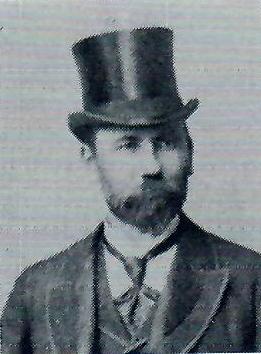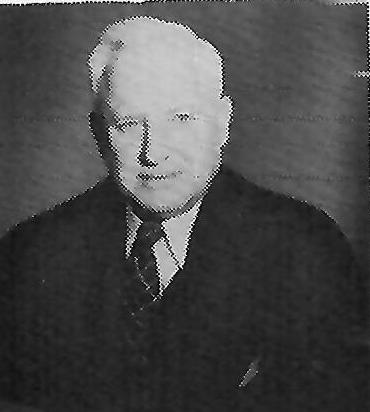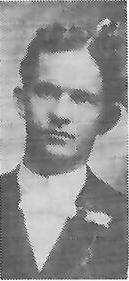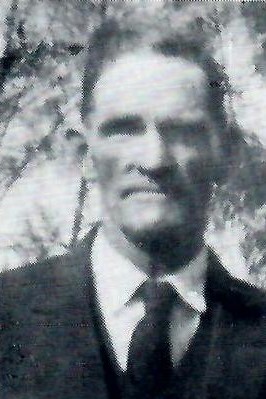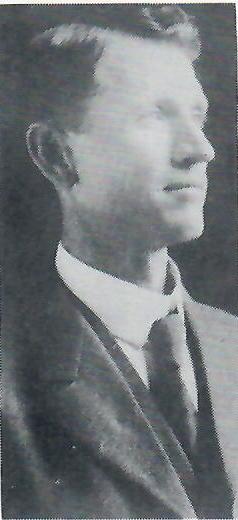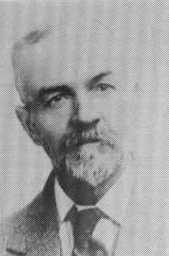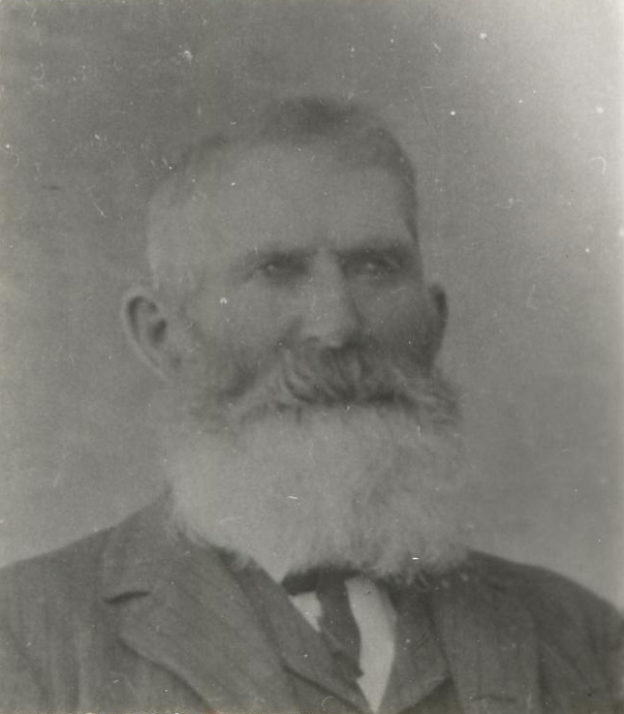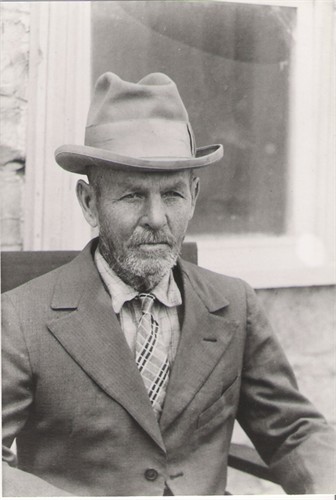Edward Christian Eyring
(1868-1959)
I was born in St. George, Utah, May 23, 1868, the second son and fourth child of Henry and Mary Bommeli Eyring. I grew up as most children of the time did. My first remembrance was going with the family to Salt Lake City, to see my first railroad train. On our way home we lost our mules but arrived home safely.
My father went on a mission to Germany and I remember Henry and I in Washington, Utah when I was eight years old. I remember also that I worked for Solon Foster at that age driving a team for ten cents a day and enjoying it very much. At that age my father bought land that gave employment to Henry and me, who worked it. The height of my ambition then was to own six pretty black mules, two wagons and to be a real freighter. Later my ideal was to be a real cowboy, own a ranch and lots of cattle.
I went to school but didn’t like it too well. Yet my father sent me to he Brigham Young Academy in Provo when I was seventeen. I liked better to work with my uncle on a ferry over the Colorado River in the summer. I used to swim in the river, often going down at nights to cool off when the nights were too hot to sleep. We also used to boat ride on the river. Ferrying was fascinating work. One time when the river was high we went over the rapids with a big freight outfit, then we had to tow the boat up the other side of the landing. Uncle was a splendid hand at the ferry business, employing several Indians. One time we went up the river about ten miles and brought back a big raft of wood and railroad timbers. Uncle Daniel, Aunt Ann, cousins Isabel, George, Frank and Alice were the relatives with whom I spent the summer, and who were very kind to me. When I returned to school in the fall, George went with me.
My schooling that winter was cut short, however, for in February, my father needed me to accompany him to Mexico to drive a team. We left St. George for Mexico on February 10, 1887. Father, Aunt Deseret, Annie, Andrew, and I were in the company. Andrew was then only three years of age. We went by way of Price, Scandlens Ferry, Hackberry, Mesa, Tucson, Fort Bowie, San Simon, and La Ascension, arriving in Mexico in April, 1887. We had quite an agreeable trip, traveling in company with Eli Whipple and family. Brother Whipple had hired Joseph Bryner to help him. He was a good friend of mine for we had grown up together. Accordingly, we had good times together hunting as we traveled along. The Indians were periodically bad, and we had one little scare at San Simon, where an Apache raid had taken place about the time we passed.
On arriving at the customs house in La Ascension, we began to learn something of Mexico and the Mexicans. We arrived in Colonia Juarez, all O.K. and settled on the Old Town site two miles below the new town. We commenced at once to fence lots and to get out logs for houses. After one month’s stay in Mexico I started back to the United States in company of Joe Bryner. We went to San Jose on the Mexican Central and from there by rail to EI Paso, Texas. At that time EI Paso was just a little frontier town, with a population of about four thousand people. We went from there into New Mexico and got work on a sawmill where we worked all summer.
The next winter I went back to St. George and went to school. The next spring I went to Arizona and took employment on my Uncle’s cattle ranch at Quail Springs, sixty miles southeast of the Colorado Ferry. I stayed there with my cousin George, our nearest neighbor living ten miles away. Sometimes George would go away and I would be alone for two or three weeks, never seeing a white man in that time and seldom an Indian. I quite enjoyed the ranch work. I liked to practice roping cattle and breaking broncos, and got, I thought, quite proficient. I remained there over a year. I got a lot of good experience there. George was a good cowboy, a good roper, and a good horseman. I learned a good many things, which helped me in the cattle business later on in Mexico.
Father needed to have me come to Mexico at this time to help him in the store. I was twenty-one years old in 1889, and the colonies had begun to be quite prosperous, as I found when I returned. It was splendid grass country, in which cattle and horses did well. While I helped my father in the store I found time to use the money I had saved while working in Colorado to buy up a few ponies and to trade for horses, which I enjoyed. I grew up with a natural love for horses and cattle and dearly loved to work with them.
In 1893, I bought a lot and made preparations for building a home. On October 11, 1893, Caroline Romney and I were married in the Salt Lake Temple. I had proposed to her prior to this time, but it took me two years to convert her father to the idea. However, he finally approved and later paid me a very fine compliment, saying, he thought I was an ideal husband. Caroline and I commenced housekeeping under many obstacles. We had only a straw tick and very little furniture, but we were extremely happy. Our own home was being built and was soon ready for us. Before long we were quite comfortable, considering the times and country.
I continued working in the store for awhile. However, I had a number of horses which I had hired out to the Davis boys who were using them to haul lumber out of the mountains. When the railroading commenced I took my teams out on the railroad grade and worked there until the grading was finished as far as Colonia Dublan. I then stopped working on the grade and sold and traded my teams, getting ready to go on a mission to Germany. My first daughter, Camilla, was born December 7, 1894. We then learned what childbearing meant. I wondered many times that night if I would have a wife or child by morning, but, oh, the joy when we finally succeeded.
I started on my mission the first of October 1897 going with my father and mother to Salt Lake City. When I went out to get in the carriage, I threw my tobacco away and have never tasted it since. If my mission did nothing more for me than that, that alone would be worth it. I have often wondered if I should ever have been able to discontinue its use, had I not gone on my mission. My wife was very brave, never making a complaint while I was away and was able to earn enough to keep me on my mission, but she worked very hard.
I left Salt Lake City with a number of Elders, James Skousen going as far as Liverpool with me, and Walter Romney and Ernest Schutler of Salt Lake City going on to Berne, Switzerland. On our way we visited Chicago, Washington, D.C., Baltimore, and Philadelphia, embarking at the latter place on the S.S. Belganland, a small second class boat. The commencement of the journey was marvelous, sailing down the river, but the next morning the wind had risen and the sea was rolling high. It was not long until we were feeding the fish. Jim was sick almost the whole way over. I soon got better but I never relished my meals. I remember how happy I was when I saw the Irish coast looming up in the distance. We landed at Liverpool, having been thirteen days on the water.
We went by rail to London where we saw the sights for a few days and then started for Berne. I was seasick again crossing the channel. We traveled through France, going to Paris. From Paris, we got on the wrong train. There was no one we could talk to, as the train kept carrying us farther off the track. Finally, at Lyons we were put on the right train, but it is a queer feeling to know you are going wrong and unable to get going right. We arrived safely in Berne, the headquarters of the Swiss and German Mission, where I did some sightseeing. Then I was sent to Mannheim, Germany, where I met my cousin Henry E. Bowman, who was my first missionary companion, and with him I began the study of the German language. After three months Henry was called to Berne to preside there and I was left alone in the branch. I will never forget how lonely I felt, but I got along nicely. I didn’t speak English for three months.
We had a lot of old timers in the branch, who were none too lively in the Faith, but we did the best we could with them. I found there a man in my tracting who afterwards joined the Church and now after thirty years, has just finished a mission to Germany. Our efforts sometimes bear fruits. I remained in Mannheim one year, going from there to [what was called] Frankfort-on-Maine, where I enjoyed my work very much. While laboring in Mannheim I made an excursion trip down the Rhine River to Koln. It is the most beautiful place I have ever seen…cliffs, the castles, vineyards on the steep hillside, all most wonderful. Koln is such an interesting old town. The old Koln dome took six hundred years to construct.
A little later, Brother Schutler and I were sent to Nene Vied on the Rhine to open a branch. There we found it quite difficult to do much because most of the people were Catholic. Three months later we returned to Frankfurt where I remained until I was released. Then I made an extended tour of Germany, Berlin, Dresden and Mannheim. While I was in Mannheim, Henry Bowman and I visited Koburg, my father’S birthplace. We passed through the old town where Martin Luther translated the Bible, and saw the spot on the wall of the old castle where he threw the ink bottle at the devil. We met Aunt Clara in Koburg. She took us all around, showing us the old family home, the cemetery where so many of our people are buried. On my return home we went through Paris, taking in the sights. Then I went to Glasgow, Scotland, which was a very dirty city, the river and docks being simply thick with oil and smoke, from where I embarked for New York City. My homeward journey was better than the one going over, for I was not seasick. I landed in New York and remained there a few days sight-seeing. Going overland, I visited Niagara Falls, Chicago, Kansas City, Independence and El Paso, Texas.
When I arrived home I found my wife better. She was just recovering from a very severe illness. Camilla was then a big girl of five years, and Mary, whom I had never seen, was two years old. I had not known that Mary had been born deaf. I think I never felt so badly in my life over anything. Nevertheless, I felt to praise the Lord that everything was as well as it was. I went back into the store to work, but decided it was too slow and that the cattle business might be better. Accordingly, I secured the job of tending the company pasture and commenced to buy stock in it. I succeeded in getting considerable stock and later, when we decided to separate, I got still more. I traded for the Palo Quemado Ranch of six thousand acres, which we used for our cattle in the summer, moving them back to the Tinaja for the winter. When Dennison E. Harris left, I bought his cattle and pasture interests. Then my cattle interest grew.
When Father died in 1902, Andrew and I continued to run our cattle together. I think the happiest time of my life was when we ran the dairy on the Tinaja, breaking broncos and caring for fat cattle on those green grassy hills. A t that time the colonies were in their best days, everyone was prospering and there were good schools and good times for all.
In 1903, I decided to enter the holy order of plural marriage, so with the help of my wife, I was able to woo my wife’s sister, Emma, and after considerable persuasion, I married her in November of 1903. We then built her a home on the lot joining ours. My idea of plural marriage was strict equality, which I have tried to practice all these years.
In 1905 we moved across the river to be closer to the Juarez Stake Academy, so I bought a number of lots from James C. Peterson and one hundred acres of pasture and land adjoining. There we built two very comfortable homes (brick) and were living very happily together-too much so-for the best good of mortals. I feel now that the twenty-five years of my life spent in Mexico were wonderful indeed. In July 1912, owing to Revolutionary conditions in Mexico, we were forced to move into the United States. At the time of leaving we had not the slightest idea we were making a permanent move. The families going out on the train took only a few necessary articles to last for a couple of weeks when we expected we would return. Most of the men remained in the country to guard the property, but conditions became so unbearable, that we knew sooner or later something terrible would happen. Accordingly, we decided to pack up, just leave everything, and move for the border. This we did, arriving at Hachita and leaving our horses there. From there we went to El Paso where we had sent our families. Even then we could not realize we were not going back.
We remained in El Paso hoping for encouraging signs that we might return. We waited to see how it went with some of the brethren who went in to see how things were. When they were forced to come out again, our hopes wavered. Finally seeing the futility of going back there now, we decided to move to Arizona. We had lived in EI Paso ten months. I moved to Safford, Arizona, and bought the Corder place, going in partnership with Miles A. Romney. This deal soon proved unsatisfactory so I sold out to Miles. By this time I had decided there was no possible chance of returning to Mexico, now or ever, to operate my prosperous business there, and that I had just as well abandon the idea. I tried the livery business as a substitute for a few months but soon saw there was no future in that. So I traded it for the Rogers farm in Pima, and moved my family there. As part of the farm was still brush, it was uphill business getting settled. There was only one two-roomed house on it so we had to pitch tents for part of the family. Getting a comfortable home built, lands cleared and under cultivation, and still keeping the family fed and clothed, was a superhuman task and one that could not have been possible had not the Lord helped us as we struggled to establish ourselves.
Yet by about 1922 I decided the Pima farm was just too small to sustain my family, and there being a colonizing project under way on the upper Gila, I gave it a try. Taking Emma and family with me, and leaving Eddie who had just returned from a mission, to operate the farm in Pima and care for his mother, we threw in our lot with this company. But after a year of the hardest work, and the heaviest kind of soil to work with and being betrayed by the perfidy of land dealers, we returned to Pima worse off than when we left.
The dividends from the Tinaja property in Mexico proved our salvation. I had traded it off in 1916 for a store in Safford, Arizona which Andrew took part interest in and ran for me. But by trading it for land in Mexico and selling Andrew’s property in Mexico to Miles Romney, we began to see daylight. Eddie had done well with the Pima farm. We still have the farm, the comfortable duplex we built on it and are thankful for getting the mortgage gradually paid off while still keeping all the children in school. I will add that I have recorded only a small part of the deals, trades and monies I made to better our future after the Exodus, for there is not space to record one hundredth part of them.
In 1931 all of my mother’s family met in Mesa and spent three months together doing temple work. Besides our good times together, we were able to do many names, most of them for our own progenitors. Had it not been for the pleadings and encouragement of my brother Henry, who is blind, this gathering would not have taken place, nor this history written. I will close this history by giving my testimony concerning the principle of plural marriage. This will no doubt be obnoxious to some who may read it. Even some of our descendants may wish it had been otherwise. I wish to impress this fact upon the minds of my children: that to discredit the principle of plural marriage is the same as discrediting any other principle of the Mormon doctrine as they all come from the same source. Joseph Smith the Prophet was commanded to establish this principle in the Church. I testify to you that I know my father entered into the principle in full faith of receiving a generous reward from our Heavenly Father for his honest efforts to live it properly. The same can be said of my father-in-law, Miles P. Romney, and I testify to you myself after twenty-eight years’ experience in trying to live it that I know the principle is divine. Although it is at the present time unlawful both from the Church’s view as well as from the standpoint of the state, I know it was established by God. Those who have lived it faithfully and well will receive a very enviable reward in the world to come. We are very thankful that the great government of the United States has granted amnesty to our people, and it is up to us to submit to the laws and to uphold the same.
Edward Christian Eyring
Stalwarts South of the Border by Nelle Spilsbury Hatch, page 146

